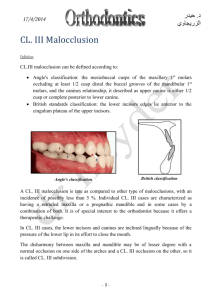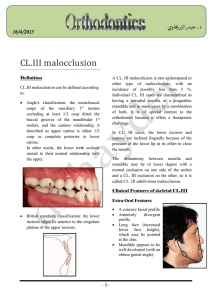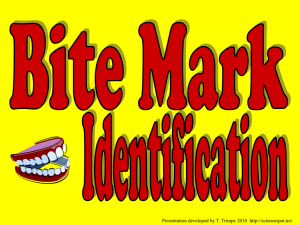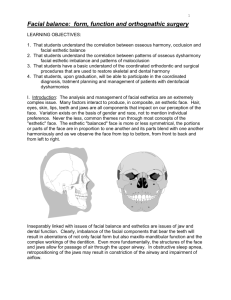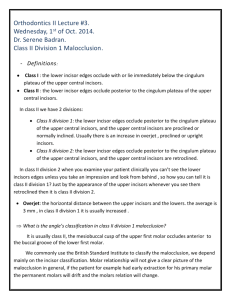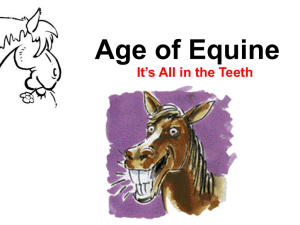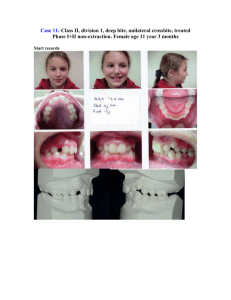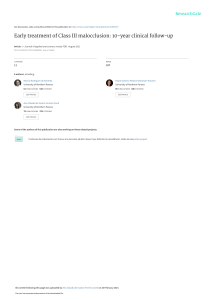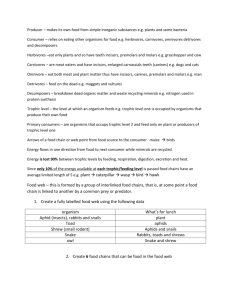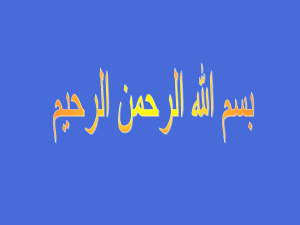might
advertisement
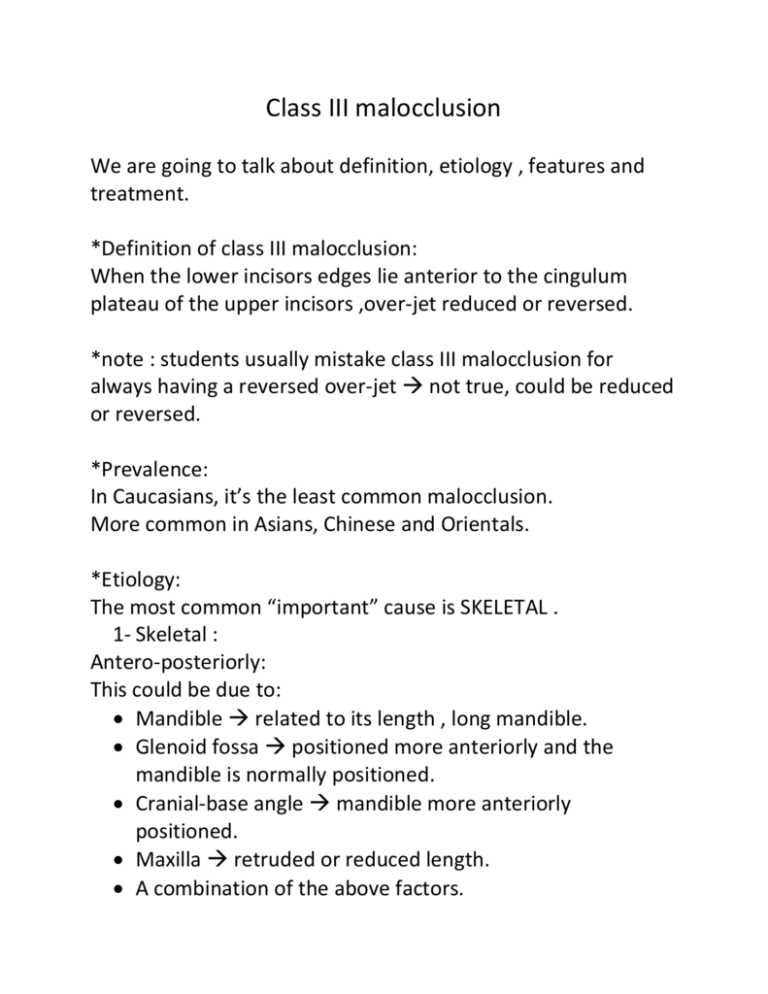
Class III malocclusion We are going to talk about definition, etiology , features and treatment. *Definition of class III malocclusion: When the lower incisors edges lie anterior to the cingulum plateau of the upper incisors ,over-jet reduced or reversed. *note : students usually mistake class III malocclusion for always having a reversed over-jet not true, could be reduced or reversed. *Prevalence: In Caucasians, it’s the least common malocclusion. More common in Asians, Chinese and Orientals. *Etiology: The most common “important” cause is SKELETAL . 1- Skeletal : Antero-posteriorly: This could be due to: Mandible related to its length , long mandible. Glenoid fossa positioned more anteriorly and the mandible is normally positioned. Cranial-base angle mandible more anteriorly positioned. Maxilla retruded or reduced length. A combination of the above factors. Inheritance and genetic factor are very important. In the past, Habsburg was a royal family in Spain and it was noticed through their paintings that they have a prominent chin “class III skeletal” so they called it Habsburg jaw. ** note : an important term to know is pseudo- class III : It’s caused by anterior mandibular shift to occlusal interference. Ex : upper incisors are retroclined due to delayed loss of primary incisors so they erupt in a palatal position. When the pt closes his mouth, he can’t achieve maximum intercuspation due to upper incisors position so the mandible shifts forward. Pseudo-class III : *doesn’t reflect an actual situation. * is not caused by skeletal factors. *less severe than it looks. *just remove interference. A student asked why not consider pseudo-class III a true class III caused by dental factor ? Because when the interference is removed we have no longer have a problem or have a minor malocclusion that can be fixed easily. Displacement: It’s the lateral/sagittal movement of the mandible from the rest position to maximum intercuspation due to premature contact or occlusal interference. can be due anterior or posterior cross bite. Vertical plane : Lower facial height could be: 1- Normal. 2- Increased. 3- Reduced. So no specific feature. Transverse plane: Also variable , no specific feature. 2- Soft tissue factor: They in favor. Lip to lip contact. In class III malocclusion, unlike class II, the soft tissues play a favorable role in the malocclusion. (how?) they help in dental compensation by retroclining lower incisors and proclining upper incisors. So usually soft tissue encourage compensation and are NOT considered a causative for class III malocclusion. ** note : sometime class III is implicated by large tongue pressing against the mandible forward but this is rare and soft tissues mostly help in dento-alveolar compensation. That’s why sometimes we see a pt with class III malocclusion but because the soft tissues are well balanced the pt doesn’t give you class III profile unless you checked him intra-orally or clinically or ceph analysis. 3- Dento-alveolar factor: Crowding or spacing: Crowding in the upper arch because maxilla length is small, spacing “or well- aligned” in the lower arch because mandible is wide. 4- Local factors : Small upper lateral incisors: causes more space in the maxilla retroclination of the centrals increase the severity of the malocclusion. ** Occlusal features of Class III: 1- Over-jet: it’s reduced or reversed “-ve over-jet” , might be zero “ when edge to edge incisors”. 2- Over-bite: reflect the skeletal relationship , so might be normal, reduced or increased. 3- Cross-bite: usually present (why?) Wide lower arch, narrow upper arch. If upper arch is U shaped and lower arch is V shaped , so the wider part of the mandible becomes against the narrow maxilla causing cross-bite scissor crossbite, unlike class II “buccal cross-bite”. That’s why when we treat class III pt with appliances we usually need to have expansion screw to widen the maxilla. ** note: if the wider part of the mandible lies against maxilla we have cross-bite but if displacement happens due to interference this is pseudo-class III. Now the treatment aims: 1- Aesthetics 2- Function 3- Relieve crowding 4- Correct over-jet and over-bite. So we have to know the problems in class III order to choose the right treatment, Problems: Growth: if growth is beyond normal which is usually the case in class III. Sometimes we can’t choose the treatment, whether to camouflage or do surgery, so we have to wait till growth is seized, plus we can use lateral ceph and x-rays for a year and monitor the growth of the pt, then we decide how to treat him usually referred to a specialist. Factors affecting treatment: 1- The pt main complain: sometimes the pt is not concerned about the facial appearance and just wants to correct his teeth “dental problem” or the opposite, he has no problem with his teeth but more concerned about his facial appearance. 2- Family history: if the pt presented to you clinic with a family history of Class III malocclusion, and all of them underwent surgery to fix it, the pt most probably will be treated surgically too genes role. 3- Severity: if the malocclusion is mild it can be treated by camouflage , but if it’s moderate or severe then surgery is the treatment option so only mild cases we can camouflage it. 4- Can the pt achieve edge to edge contact: it’s the 1st test of function, it’s a good sign if it’s achieved it means we might be able to treat him with orthodontic appliances without surgery, but sometimes it doesn’t work and we have to treat them surgically. But if the pt couldn’t achieve edge to edge contact , this usually means surgical treatment is the option. 5- Degree of crowding: if the lower arch is crowded then we have to deal with this crowding and every space available is utilized to treat this instead of compensating for class III malocclusion this is not in our favor because we want to retrocline not procline them. If the upper arch is crowded we can relieve crowding by proclination in our favor. ** how much dento-alveolar compensation can be done ? If the upper incisors are already proclined it’s harder to procline them further. If the lower incisors are already retroclined it’s harder to retrocline them further. Now treatment options: 1- Accept 2- Camouflage 3- Growth modification 4- Surgery. When to accept the malocclusion : If the patient is not motivated and has poor oral hygiene. If the pt is happy and not concerned about his malocclusion unless he has a tumor or problem in the mandible that needs surgical intervention. George Clooney , Jay Lennon both have class III malocclusion it’s taken as a sign of muscularity “strong chin” , unlike class II “feminine look”. 2- camouflage: (when?): Pseudo-class III Mild malocclusion. When growth-modification can’t be applied in older group How do we camouflage: By correcting incisal relationship and occlusion and accepting skeletal pattern. Extraction, non- extraction: Non-extraction by proclination of the uppers and retroclination of the lowers. Extraction: we extract in the lower arch teeth that are close to the anterior teeth so we extract 4s . The problem is stability and fear of relapse. ** if a pt came with a class III and we extracted lower teeth then did orthodontic appliances, he will come back after 3 yrs with his condition worse than when he started then we have to do surgery as it’s our only option so we don’t undertake extraction unless we are sure of the result and stability. What appliance to use “removable or fixed” ? Removable appliances: “ it usually treats upper arch” If the case is mild we usually use removable appliances to procline upper incisors. At the end of the treatment we will have +ve over-jet and overbite but if over-bite was already reduced then proclination we still give us reduced over-bite. If the uppers are retroclined or upright and lower are normally inclined. So when we are dealing when upper arch only or the cause of the class III is retrocline upper incisors we use removable appliances. Other than these cases we use fixed appliances. Removable appliance design: Components: Active : anterior screw Retention: 4 points of retention including anterior retention “labial bow on lower incisors so acrylic won’t slip from incisors”. Posterior bite plane to disocclude teeth. Screw is adjusted twice a week , 0.25 mm turn. Or we can use palatal spring, z-spring with 4 points if retention So we can have more than one design. If : Upper are normally inclined Lower proclined and spaced. Fixed for lower arch with removable appliances for upper can be used + elastics. 3- growth modification (when?) : notice it’s listed as number 3 here: Growing pt Earlier than class II intervention time Best time when upper incisors erupt “ 7-8 yrs” (How ?) Protrusion of maxilla :We deal with upper jaw by moving it forward opening circum-maxillary suture or making it patent. Mandibular growth restrain “redirection” Devices used : Chin cup: it was used when scientists thought that condyle is a growth center , so they can restrain the mandible growth, later it was proved to be a growth site which means it only redirect the mandible’s growth rotates backward and retrocline incisors. **Not suitable with a case of already reduced overbite or already retroclined lower incisors. Functional appliance: proved on animal studies Have dental effect only. Retrocline the lower incisors and procline upper incisors. No jaw growth modification. Ex: *frankel type III : has a labial bow on lower incisors dento-alveolar effect proclination of upper incisors. * reversed twin block : lower block behind upper block dento-alveolar effect. *A new device called BAMP “ bone anchored maxillary protractor” : we have a plate on the upper posterior area and lower anterior area + strong elastics + surgical intervention no dental effect, only skeletal growth gives good results but no long term studies invasive. * face mask : most successful growth modification functional appliance. Consists of : metal framework, headrest, chin rest, bar , appliance with hooks, elastics, rods and Upper expansion screws. Target is the maxilla forward movement. Can be used with fixed or removable appliance. Effect : 1) disarticulate upper sutures. 2) maxilla moves forward. 3) upper incisors proclination. Note : stress could retrocline lowers and rotate mandible backward but main effect on maxilla. * sometimes there is a combination of facemask and BAMP . 4- surgery : When growth modification fails after the age of 10yrs when growth stops when camouflage fails too. Class III moderate or severe. When main concern is the face not dentition. We can perform surgery on maxilla or mandible or both. So surgery should be performed after growth stops. Now stability :Short term stability depends on over-bite +ve stop. Long term stability depends on growth that’s why we don’t start until growth stops should be monitored by series of xrays for a year and ceph analysis. Done by : Noor hilal
